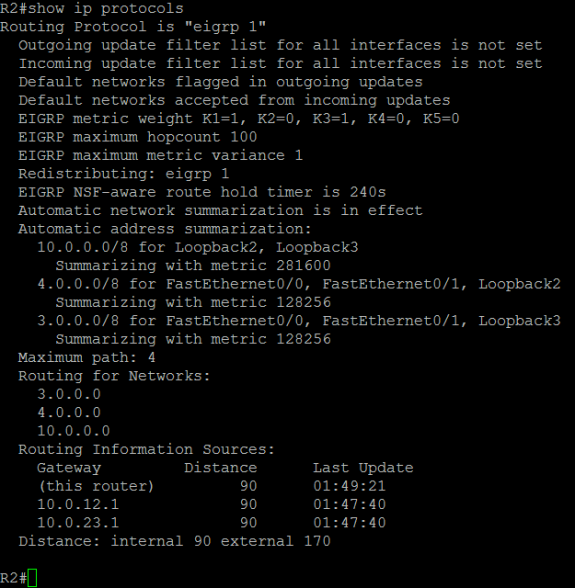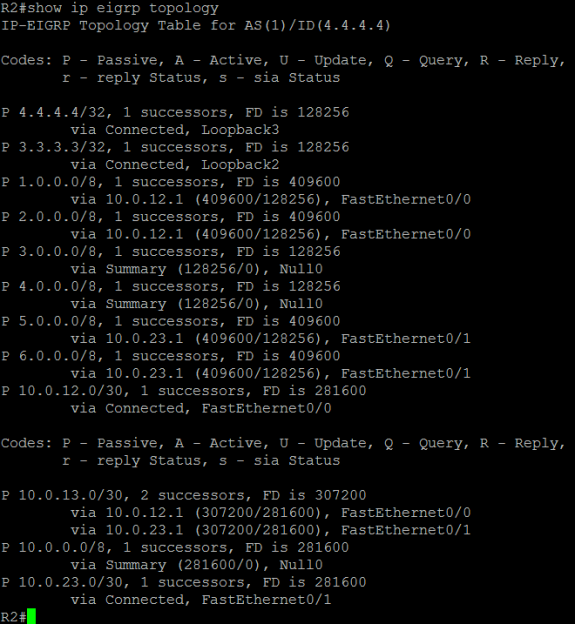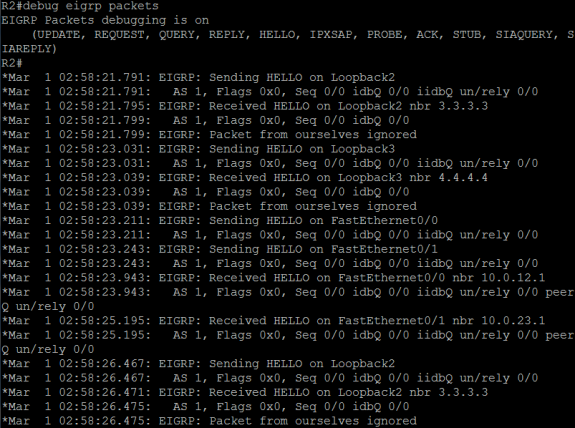I discussed Enhanced Interior Gateway Routing Protocol (EIGRP) briefly in a prior blog, Load Balancing with EIGRP, however, in this lab I use two Cisco 3725 routers [IOS 12.4(15)T10] to demonstrate how to configure EIGRP; additionally, I’ll discuss some useful troubleshooting commands. Remember EIGRP is a Cisco proprietary routing protocol which allows for load balancing over equal and unequal links. When EIGRP is enabled, the router attempts to discover neighbors on interfaces by sending multicast EIGRP Hello messages via multicast address 224.0.0.10. The router then advertises to other neighbors about the subnets connected to its respective interfaces. Below is a diagram of the lab setup I will be using.
See below for the configuration I used on each of the respective routers. Take note of the fact that no wildcard-mask is used with the network command, so the single parameter must be a classful network number. The command enables EIGRP on all interfaces directly connected to the configured classfull network.
R1 Configuration:
– enable
– configure terminal
– interface fastEthernet 0/0
– ip address 10.0.12.1 255.255.255.252
– no shutdown
– exit– interface fastEthernet 0/1
– ip address 10.0.13.1 255.255.255.252
– no shutdown
– exit– interface loopback 0
– ip address 1.1.1.1 255.255.255.255
– exit– interface loopback 1
– ip address 2.2.2.2 255.255.255.255
– exit– router eigrp 1
– network 10.0.0.0
– network 1.1.1.1
– network 2.2.2.2
– exit
– exit
– write
R2 Configuration:
– enable
– configure terminal
– interface fastEthernet 0/0
– ip address 10.0.12.2 255.255.255.252
– no shutdown
– exit– interface fastEthernet 0/1
– ip address 10.0.23.2 255.255.255.252
– no shutdown
– exit– interface loopback 2
– ip address 3.3.3.3 255.255.255.255
– exit– interface loopback 3
– ip address 4.4.4.4 255.255.255.255– router eigrp 1
– network 10.0.0.0
– network 3.3.3.3
– network 4.4.4.4– exit
– exit
– write
R3 Configuration:
– enable
– configure terminal
– interface fastEthernet 0/0
– ip address 10.0.13.2 255.255.255.252
– no shutdown
– exit– interface fastEthernet 0/1
– ip address 10.0.23.1 255.255.255.252
– no shutdown
– exit– interface loopback 4
– ip address 5.5.5.5 255.255.255.255
– exit– interface loopback 5
– ip address 6.6.6.6 255.255.255.255
– router eigrp 1
– network 10.0.0.0
– network 5.5.5.5
– network 6.6.6.6
– exit
– exit
– write
Useful EIGRP commands:
– show ip protocols (lists configured network commands and networks being routed for)
– show ip route (lists all successor and feasible successor routes)
– show ip eigrp interfaces (lists the contents of the routing table; EIGRP routes listed with a ‘D’)
– show ip eigrp neighbors (lists known neighbors)
– show ip eigrp topology (lists all successor and feasible successor routes)
– debug eigrp packets (lists hello packets sent/received between adjacent routers)
– debug ip eigrp notification (lists eigrp changes/updates as they occur)











 Twitter
Twitter LinkedIn
LinkedIn Youtube
Youtube RSS
RSS